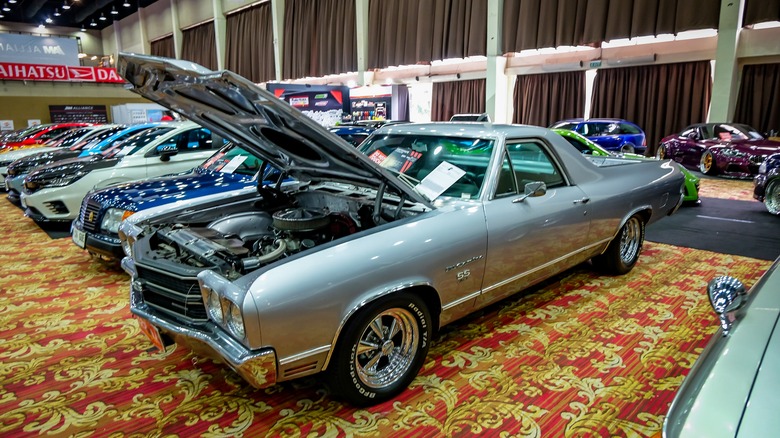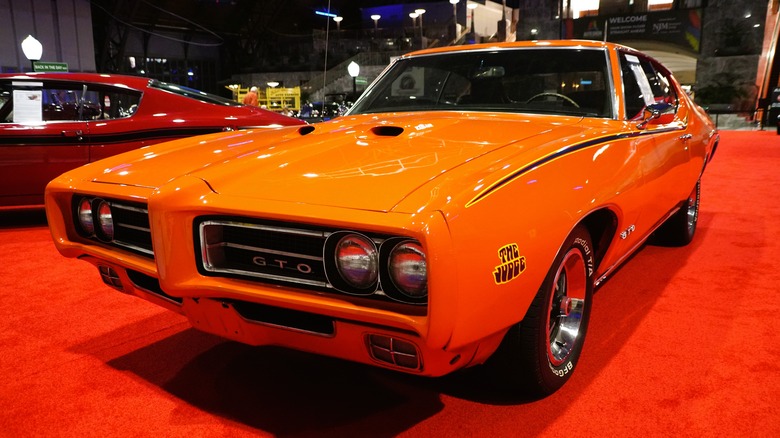5 Classic Muscle Cars That Could Hold Their Own Against The 1971 HEMI Cuda
Chrysler launched the Plymouth division in 1928 and kept it in the family until 2001 before redundancy and failure to bring in revenue doomed the brand. Plymouth produced more than its share of muscle cars during that era's heyday in the mid to late 1960s, like the Road Runner, the GTX, and the Sport Fury. The brand's zenith may have been the 1971 HEMI-powered 'Cuda, which could go 140 miles per hour, sprint from 0-60 in just 5.2 seconds, and cover a quarter mile in 14 seconds at 102 mph.
While the 2024 Hyundai Ioniq 5 can go from 0-60 in less than 4.5 seconds, 5.2 was an elite time for 1971. With the catalytic converter mandate and Corporate Average Fuel Economy standards still on the horizon, the HEMI 'Cuda had plenty of competition among its contemporaries. Here are five muscle cars from the late '60s and early '70s that could give the HEMI 'Cuda a run for its money on the street or the dragstrip.
1969 COPO Chevrolet Camaro ZL1
The 1969 COPO (Central Office Production Order) Chevy Camaro ZL1 earned almost instant legend status when Illinois Chevy dealer Fred Gibb — who happened to run drag races on the side — put together a package that included a 427-cubic inch V8 with an aluminum block and heads that shaved about 100 pounds from the standard-issue 396's bulk. Gibb ordered 50 cars, 10 each in silver, green, orange, and two shades of blue.
They all had Positraction rear axles with a 4.10:1 gear ratio, upgraded rear springs and radiators, and power front disc brakes. Gibb's custom package was given the designation 9560, which differentiated it from the 9561 COPO package created by Don Yenko, which had an iron-block 427.
Chevy built 69 Camaros with the 9560 package, with about 20 going straight to the dragstrip and the rest to Gibbs' dealership. He was only able to sell 13 of them, and the failed investment almost sunk him financially. The COPO Camaro' ZL1s 5.3 second 0-60 time put it just a tick behind the 1971 HEMI 'Cuda, although it topped out at "only" 125 miles per hour.
[Featured image by Sicnag via Wikimedia Commons | Cropped and scaled | CC By 2.0]
1970 Chevrolet El Camino SS 454
The year after the COPO Camaro ZL1 almost bankrupted Fred Gibb, Chevy dropped in the 454-cubic inch LS6 V8 into about 4,500 cars. About 4,000 of those were Chevelles. The rest of those 450-horsepower big blocks went into the El Camino Super Sport (SS). The El Camino had been introduced in 1959 and was in its third generation. The beastliest of all gear-haulers could more than keep up with the HEMI 'Cuda; its 5.1-second 0-60 time and 12.74-second quarter mile pace were both slightly better than the Plymouth's.
Sadly, the government mandates for unleaded fuel and catalytic converters sucked some of the fun out of the El Camino in the years to come. LS6-powered El Caminos are virtually impossible to find these days, with most original-condition El Camino survivors from 1970 hiding a 396-cubic inch V8 under their long hoods. One went up for sale on Bring a Trailer earlier this year, but the $175,000 top bid wasn't enough to separate it from its owner.
1969 Dodge Charger 500
Long before Dodge resurrected the Charger in 2006, the model was on dealership lots to help satisfy NASCAR homologation requirements. To qualify for stock car racing, manufacturers had to offer a car for sale to ordinary people of the world in sufficient numbers. In 1969, Dodge offered two high-powered versions of the Charger to meet the NASCAR mandate: the aptly named Charger Daytona and the equally as impressive Charger 500. The latter took its name from the number of cars NASCAR required to be produced for homologation, although the American Muscle Car Museum reports than only 392 were built that year.
Two HEMI engines were available in displacements of 426 and 440 cubic inches. Surprisingly, the smaller offering was the more powerful, thanks to its twin four-barrel Carter carburetors that gulped fuel at a rate of 8.1 miles per gallon. That sacrifice at the pump got Charger 500 owners the glory of a 5-second 0-60 time, top speed of 137 miles per hour, and a quarter mile pace of 13.6 seconds.
[Featured image by Button74 via Wikimedia Commons | Cropped and scaled | CC BY-SA 4.0]
1969 Pontiac GTO Judge
The Pontiac GTO is often credited with introducing the muscle car concept in 1964, and by 1969 its popularity led Pontiac to introduce a special edition, the Judge. John DeLorean, who created the GTO, was a fan of the TV comedy sketch show "Rowan & Martin's Laugh-In," which featured a character known as "The Judge" played by Sammy Davis Jr. The GTO Judge was initially only available in Carousel Red, a color that appears more orange to most eyes.
Along with the swooping, body-length black and yellow stripes and fender graphics spelling out "The Judge" in a psychedelic font, the GTO Judge had a 400-cubic inch V8 with Ram Air intake, Hurst shifter, rear spoiler, and Rally wheels with wide tires. With a Rochester four-barrel carburetor feeding it gas, the GTO Judge could hold court to the tune of 5.2 seconds from 0-60 and 13.8 seconds over the quarter mile, putting it wheel-to-wheel with the 1971 HEMI 'Cuda.
1970 Oldsmobile 4-4-2 W-30
One of the '71 HEMI 'Cuda's most formidable challengers was the 1970 Oldsmobile 4-4-2, which took its name from the arrangement of a four-barrel carburetor, four-speed transmission, and twin exhausts. The 4-4-2 was introduced in 1964 as Oldsmobile's answer to the GTO. It was a bit of a dud that first year, and Oldsmobile expanded the package for 1965 to include a bigger V8 and significant improvements to its handling. The 4-4-2 began as an option package on the F-85 and Cutlass and became a standalone nameplate in 1968.
For the 1970 model, Olds replaced the 400-cubic inch V8 with a 455-cubic inch beast with bigger ports and a Rochester four-barrel carburetor. Weight savings came thanks to a fiberglass hood with twin scoops, an aluminum intake manifold, and plastic fender liners. The performance-oriented W-30 package included a specially tuned four-barrel carburetor, hot cam, and free-flowing exhaust system. So equipped, the 1970 4-4-2 could get from 0-60 in 5.6 seconds and cover a quarter mile in 14.3 ticks of the timer.
[Featured image by Greg Gjerdingen via Wikimedia Commons | Cropped and scaled | CC BY-SA 2.0]





